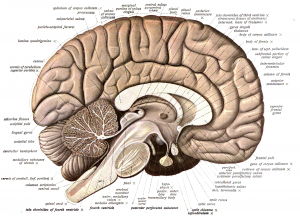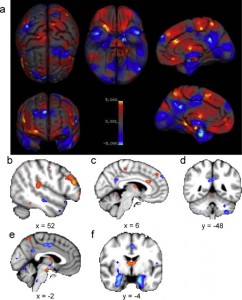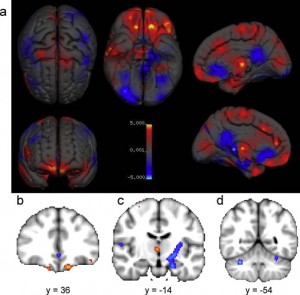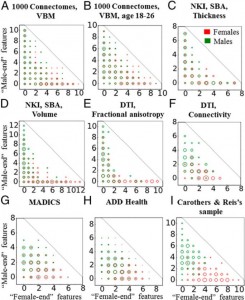
On 5th December 2015 the New Scientist ran an article titled Brains are not male or female, and subtitled First analysis of the whole brain suggests gender distinctions are often meaningless. I thought this rather curious because it seemed to conflict with what I had read previously about sex differences in brain structure.
The study which was being reported by New Scientist was Ref.1. The lead author is Daphna Joel, professor of psychology at Tel Aviv University. I make a few observations, below, regarding the gender political leaning of Ref.1 and the New Scientist article. I then examine the findings of Ref.1 as well as the findings of an earlier study of sex differences in brain structure. My contention will be that the actual findings support substantial sex differences in brain structure, and this applies as much to Ref.1 itself as to earlier studies, notwithstanding the spin put on the matter by New Scientist and Ref.1.
The Gender-Political Spin
In Ref.1, New Scientist informed us, subjects were classified as people who self-identified as male or female (as opposed, of course, from being male or female). We were told that the findings of Ref.1 suggest that “we all lie on a continuum of what are traditionally viewed as male and female characteristics” and that “the study is very helpful in providing biological support for something we’ve known for a long time – that gender isn’t binary” (quoting psychologist Meg Barker of the Open University).
But the mindset behind the article is betrayed by this quote from Gina Rippon, professor of cognitive neuroscience at Aston University,
This blow to the myth of distinct male and female brains is welcome.
A key barrier to equality is crumbling, thanks to a new imaging study which blows away the idea that male and female brains are distinct.
Oh dear. It is so wrong to suggest that equality of opportunity and equality of respect require indistinguishability. Difference is no barrier to equality if equality is understood in these terms. To quote Steven Pinker, from The Blank Slate,
There is, in fact, no incompatibility between the principles of feminism* and the possibility that men and women are not psychologically identical. To repeat: equality is not the empirical claim that all groups of humans are inter-changeable; it is the moral principle that individuals should not be judged or constrained by the average properties of their group. In the case of gender, the barely defeated Equal Rights Amendment put it succinctly: “Equality of Rights under the law shall not be denied or abridged by the United States or any state on account of sex”. It we recognise this principle, no one has to spin myths about the indistinguishability of the sexes to justify equality. Nor should anyone invoke sex differences to justify discriminatory policies or to hector women into doing what they don’t want to do.
*He means “equality feminism” here, not the dogmatic assertion of gender feminists that gender is socially constructed.
But the above quote from Gina Rippon reflects the feminist doctrine that gender is a social construct. From this perspective, any disparity in outcome can only be due to societal disadvantage – because men and women are actually the same and any differences in aptitude or preference are culturally imposed. The purpose of the feminist dogma of socially constructed gender is to permit all disparities of outcome to be interpreted as due to societal disadvantage – thus legitimising affirmative or corrective action. As well as being incorrect, the fundamental dishonesty of this position is betrayed by such corrective actions only ever applying to situations of female underrepresentation.
The “barrier” presented by studies showing sex differences in brain structure is not to equality but to the acceptance of feminist dogma.
The lead author of Ref.1, Daphna Joel, did not require the analysis of Ref.1 to decide that brains are not male or female. She had already decided this and gone into print some four years earlier, with this publication,
Joel D. (2011) Male or female? Brains are intersex. Frontiers in Integrative Neuroscience, 5, 57.
and also this one,
Joel, D. (2014) Sex, Gender, and Brain – A Problem of Conceptualization. In S. Schmitz and G. Höppner (Eds). Gendered Neurocultures. Feminist and Queer Perspectives on Current Brain Discourses. Vienna: Zaglossus. e.U.
She has also given a TEDx talk on the subject.
The New Scientist article quotes Joel thus,
We separate boys and girls, men and women, all the time.
No, we don’t – but they often separate themselves. Modern life tends to mix the sexes together. Most people attend mixed sex schools, mixed sex colleges or universities, and work in a mixed sex work environment (albeit not necessarily 50/50). But when this mixing of sexes is not enforced, the sexes often spontaneously segregate themselves. Here’s an example. My study window overlooks the walkway back to town from the local secondary school. What I see at school closing time are groups of boys and, separately, groups of girls, walking back home. These sex-segregated groups occur naturally despite the boys and girls having spent all day in mixed sex classes, and having done so from the age of 5. Very occasionally there will be a mixed sex group – usually just a pair – but on the whole the sexes spontaneously segregate despite their co-ed upbringing.
Ref.1 is tainted with the same gender political spin evident in the New Scientist article. It reports the significance of the study being as follows,
Sex/gender differences in the brain are of high social interest because their presence is typically assumed to prove that humans belong to two distinct categories not only in terms of their genitalia, and thus justify differential treatment of males and females.
Really? Who is using sex differences as a justification for differential treatment of males and females? Please name names. In many cases this would actually be illegal.
The truth is exactly the opposite. This brain structure study is being spun to imply no sex differences, because – if there are indeed no sex differences – then inequalities of outcome, e.g., in employment sectors, can be interpreted as discriminatory and hence justify ‘affirmative’, or corrective, action. In truth it is the claim of sex indistinguishability which facilitates differential treatment of males and females – such as all-women shortlists, targets for women on Boards, and huge public expenditure on encouraging women into STEM. Logically, such concerns should be reciprocated where men are in the minority, but they are not.
A 2014 Meta-Analysis (Ref.2)
Before we look at what Ref.1 actually reports, let’s take a look at a study from the previous year, Ref.2. This work, by Ruigrok et al, was the first meta-analysis of sex differences in human brain structure. A total of 126 articles were included in the meta-analysis, using established methodologies to find all relevant studies published between 1990 and 2013 in an unbiased way. The data covered brains from individuals as young as birth to 80 years old. A quantitative review of these brain imaging studies which addressed sex differences was carried out using sophisticated statistical techniques to establish significance. The study was restricted to grey matter and the parameters employed were local grey matter volume and local grey matter density. The objective was to identify any significant sex differences in the maps of grey matter volume or density across brain regions.
The results are shown in Figures 1 and 2 below,
Figure 1: Sex differences in grey matter volume. Female > Male in red, and Male > Female is in blue (from Ref.2) – Click to enlarge
Figure 2: Sex differences in grey matter density. Female > Male in red, and Male > Female is in blue (from Ref.2) – Click to enlarge
The extensive sex differences are readily apparent.
The report concludes,
On average males have larger total brain volumes and specifically larger ICV (12%), TBV (11%), Cb (10%), GM (9%), WM (13%), CSF(11.5%) and Cbl (9%) absolute volumes than females.
As regards these differences being congenital, rather than a product of upbringing, the report notes that data were skewed to older ages but nevertheless concludes,
We found that across a wide age range, from new-borns to individuals over 80 years old, differences in overall brain volumes are sustained between males and females.
The report stops short of making claims regarding the behavioural or clinical implications of the observed sex differences in brain structure, but notes that,
Regional sex differences in volume and tissue density include the amygdala, hippocampus and insula, areas known to be implicated in sex-biased neuropsychiatric conditions. Together, these results suggest candidate regions for investigating the asymmetric effect that sex has on the developing brain, and for understanding sex-biased neurological and psychiatric conditions.
With this background established, let’s turn to Ref.1
The Findings of Ref.1
Like Ref.2, the work of Joel et al, Ref.1, draws on a number of existing reports of MRI scans. Ref.1 uses a far smaller number of independent studies, only 6 compared with Ref.2’s 126. However, Ref.1 includes data on white matter as well as grey matter, and also includes brain connectivity (‘connectome’) data as well as volume/density data. Most importantly, Ref.1 concentrates on the male/female characteristics over a number of features for single individuals, which Ref.2 did not do.
Having identified a number of features which showed clear male-female differences, Ref.1 then defines a ‘degree of maleness or femaleness’ for each of these features. The core of the study is to present a ‘signature’ (my word) for each individual, defined as the set of maleness/femaleness scores for each of these features. These ‘signatures’ are then compiled together for the whole dataset of individuals. Note that this exercise is possible only because features were found which show clear correlations with sex.
The results are shown in Figures 3 and 4.
Figure 3: Joel et al, Ref.1, Fig.1 – Click to enlarge
Figure 4: Joel et al, Ref.1, Fig.2 – Click to enlarge
Consider firstly Figure 3E. Each horizontal line of these colour blocks is a single individual. The more pink a pixel is, the more female that brain feature; the more blue it is, the more male. So a single multi-coloured horizontal line is the ‘signature’ for that individual. The two blocks represent all the results for females (left) and males (right) stacked together. So, you can see that many females have some blue (male) bits, and many males have some pink (female) bits. But the overall picture is that – wait for it – females are predominantly female and males are predominantly male: the left block comes across as fairly pink and the right block as fairly blue. Who would have thunk it?
The same result is illustrated in a different manner by Figure 3F and the plots of Figure 4. These plot “femaleness” on the x-axis, and “maleness” on the y-axis, the overall outcome being the sum of the number of individual features which show femaleness or maleness. The pink dots or circles denote female subjects, and the green denote male subjects. The size of the circle indicates the number of individuals at that x,y position. All these plots indicate the same broad result: very few, if any, females are at the extreme male end of the spectrum (top left corner), and very few, if any, males are at the extreme female end of the spectrum (bottom right corner). Most males have middling maleness but below-middling femaleness, and vice-versa. Most people have a mixture of characteristics. Being male is associated with a predominance of male characteristics, not with the complete absence of female characteristics – and vice-versa.
The plots show this at a glance, with the bottom-right looking predominantly pink and the top left looking predominantly green.
This is completely unsurprising.
And it indicates clear sex differences in brain structure, consistent with Ref.2, albeit a statistical rather than deterministic relationship.
What is surprising is the spin put on these results in Ref.1.
One conclusion drawn in Ref.1 is,
Although there are sex/gender differences in the brain, human brains do not belong to one of two distinct categories: male brain/female brain
This conclusion is valid only in the sense that some male’s brains have equally many male and female features, and some females share the same number of male and female features as males. But this does not necessarily permit the conclusion that the brains are “the same”, a point to be amplified below.
Given a brain, a neuroscientist might not be able to tell if it were male or female. But if you gave the neuroscientist a large number of randomly sampled brains, he would get the sex right most of the time. Even New Scientist admits as much.
But the spin of Ref.1 is that, in order for brain structure to conform to the dimorphic view of gender, the expected result should have been that all males were extreme males, and all females extreme females. In other words the fact that individuals have a spectrum of characteristics is claimed to undermine the fundamental binary. The implicit claim is that the conventional (i.e., non-feminist) perspective would require all males to have a high maleness score in every feature, and all females to have a high femaleness score in every feature. On the plots of Figure 4, males would need to occur only at a maleness score of 10 and a femaleness of zero, and vice-versa.
But this is preposterous. It is surely a straw man argument. I doubt that anyone of scientific credibility, even those embracing the idea of binary gender, would have expected such a thing. In terms of function, that is in terms of skills and behaviours, the sexes do not differ so greatly that there is no overlap in their distribution of attributes. Males may be slightly better at maths on average, and females slightly better at verbal skills on average, but a female mathematician vastly exceeds in mathematical ability that of the average man, and an accomplished male author far exceeds the articulacy of the average woman. This is obvious. If it is obvious in terms of function, why should one not expect the same for brain function?
To quote Steven Pinker again,
Many psychological traits relevant to the public sphere, such as general intelligence, are the same on average for men and women, and virtually all psychological traits may be found in varying degrees among the members of each sex. No sex difference yet discovered applies to every last man compared with every last woman, so generalisations about a sex will always be untrue of many individuals. And notions like “proper role” and “natural place” are scientifically meaningless and give no grounds for restricting freedom.
So even those who espouse the importance of statistical, though not deterministic, distinctions between the sexes do not use it to “justify differential treatment of males and females”.
In contrast to the above sensible perspective, the extreme male versus extreme female idea, a view which no one holds, might lead to all males being completely illiterate and all females completely innumerate, or some such silliness. Yet Joel et al manage to smuggle in this implication, concluding,
The lack of internal consistency in human brain and gender characteristics undermines the dimorphic view of human brain and behavior and calls for a shift in our conceptualization of the relations between sex and the brain.
Here “lack of internal consistency” simply means people with a mix of male and female brain features. The straw man is the pretence that there is any credible alternative view to knock down. And the fact that all people have a mix of characteristics, a fact understood well before neuroscience by the likes of Jung and Freud, does not require any “shift in our conceptualizations”.
Joel et al continue,
Specifically, we should shift from thinking of brains as falling into two classes, one typical of males and the other typical of females, to appreciating the variability of the human brain mosaic
which, on the face of it, is fair enough. But there is a logical fallacy here which needs to be exposed…..
We have no idea how brain structure translates into function (skills, attributes, personality, psychology, etc.). Joel et al have fallen into the trap of assuming that if a set of features (label them x, y, z,….) are all correlated with maleness, then the more of these features are ‘male’ the more male the overall result will be. In maths speak, they have unwittingly snuck in an assumption of linearity. But different parts of the brain interact, do they not? And in a crucial manner, essential to their basic function. If we can speak of an overall maleness at all, it is virtually inevitable that it will be a highly non-linear function of the individual features, x, y, z….
Suppose we normalise these parameters so that 0 represents ‘male’ and 1 represents ‘female’. Let’s start by looking at just two parameters, x and y. It is a simple matter to dream up a non-linear function, f, of x and y, which we interpret as the overall ‘maleness’ which results from the two features, such that f has the following properties,
- Holding y fixed results in f being positively correlated with x, as required
- Holding x fixed results in f being positively correlated with y, as required
- Setting x = y = 0 results in f = 0 (‘full maleness’)
- Setting x = y = 1 results in f = 1 (‘full femaleness’)
- And yet, setting x = y = 0.5 does not result in f = 0.5, a person equally balanced between male and female as you might expect, but f = 0 – a fully male person!
Such a function is simply xy(1-x-y)^2.
This illustrates the danger of assuming that the outcome of two features together is a linear combination of the outcomes for the features separately. Computers are built of non-linear gates, and the firing of a single neuron is essentially non-linear.
The triviality of the above function compared with the massive complexity of brain interactions only serves to emphasise the naivety of the implicit linearity assumption in the reasoning of Ref.1.
But it gets worse. Consider now four features, x, y, p and q, normalised as before, and consider the outcome function,
f = 0.25xy(1-x-y)^2 + 0.75pq(1-p-q)^2
This function illustrates another potential flaw in the logic of Ref.1. It is a sensible function in that it fulfils the above requirements of positive correlation, and f = 0 when x = y = p = q = 0, and f = 1 when x = y = p = q =1. In Ref.1, to assess overall maleness, the number of features exhibiting maleness is counted. Thus, the outcome for x = y = 0, p = q = 1 is tacitly assumed to be the same as that for x = y = 1, p = q = 0 since both have the same total score. But the above function is different for these two inputs. In the former case we get f = 0.75 (predominantly female) and in the latter case we get f = 0.25 (predominantly male).
In short, the assumption that the outcome for a particular combination of features which individually correlate with maleness/femaleness can be judged by simple linear summation of the individual feature scores is, at best, unproved and, in all probability, wrong.
Consequently the conclusion of Ref.1 that,
Our results demonstrate that….human brains cannot be categorized into two distinct classes: male brain/female brain
is challengeable.
But things get worse when Ref.1 strays into the overtly gender political, as in the conclusion,
At the social level, adopting a view that acknowledges human variability and diversity has important implications for social debates on longstanding issues such as the desirability of single-sex education and the meaning of sex/gender as a social category.
I have no problem at all with acknowledging – in fact, I’d say, valuing – human variability and diversity. But, whatever your opinion on single sex education might be, you would have to be incredibly foolhardy to argue the point based on our current knowledge of brain structure. And I am far from convinced that Ref.1 has any impact on our perception of “sex/gender as a social category”. It’s a pity because Ref.1 is an interesting piece of science blighted by a gender political spin which is unnecessary.
And as for New Scientist hinting that this is the basis of a “genderless future” – no, it isn’t – though it would be a jolly good thing if New Scientist adopted a politically genderless editorial policy, an ideal from which it now deviates regularly.
References
- “Sex beyond the genitalia: The human brain mosaic“, PNAS, December 15, 2015, vol. 112, no. 50, 15469, Daphna Joel, Zohar Berman, Ido Tavor, Nadav Wexler, Olga Gaber, Yaniv Stein, Nisan Shefi, Jared Poole, Sebastian Urchs, Daniel S. Margulies, Franziskus Liem, Jürgen Hänggi, Lutz Jäncke, and Yaniv Assaf
- “A meta-analysis of sex differences in human brain structure“, Neuroscience & Biobehavioral Reviews, Volume 39, February 2014, Pages 34–50, Amber N.V. Ruigrok, Gholamreza Salimi-Khorshidi, Meng-Chuan Lai, Simon Baron-Cohen, Michael V. Lombardo, Roger J. Tait, John Suckling



